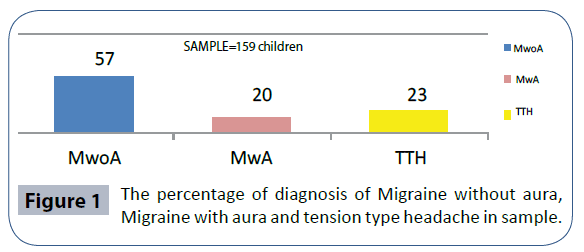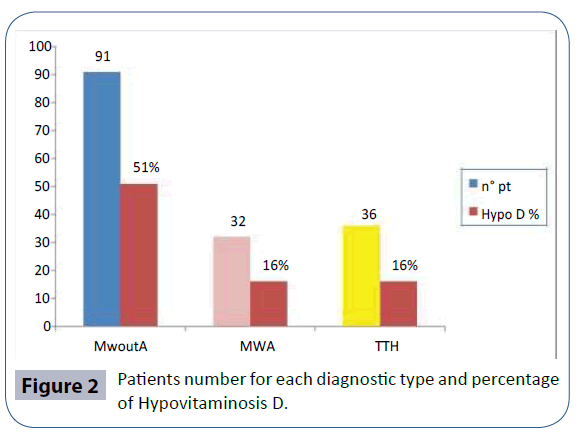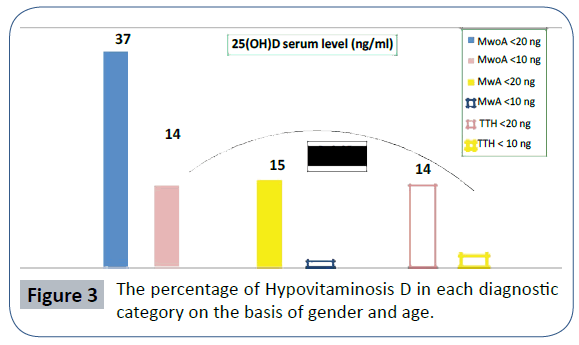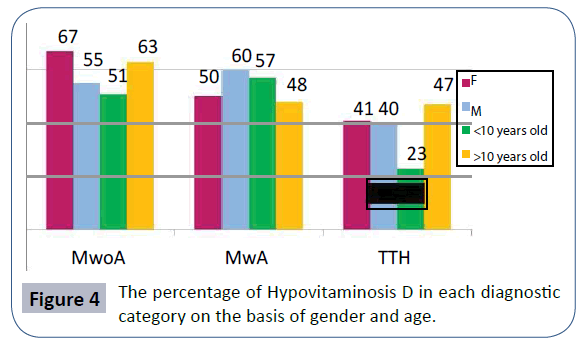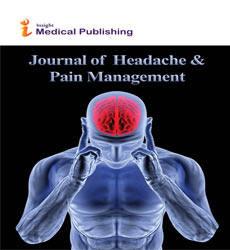Vitamin D [25(OH)D] Serum Level on Headache Children
Elisabetta Tozzi, Alessandra Boncristiano, Anna Rita Antenucci and Giovanni Farello
DOI10.4172/2472-1913.100017
Elisabetta Tozzi*, Alessandra Boncristiano, Anna Rita Antenucci and Giovanni Farello
Department of life, Health and Environmental Sciences (MESVA) University of L’Aquila Hospital of L’Aquila, Italy
- *Corresponding Author:
- Elisabetta Tozzi
Department of life
Health and Environmental Sciences (MESVA)
Via Vetoio 67010 L’AQUILA, Italy.
Tel: 0862433561
E-mail: elisabetta.tozzialleva@univaq.it
Received date: December 16, 2015; Accepted date: May 17, 2016; Published date: May 27, 2016
Citation: Tozzi E, Boncristiano A, Antenucci AR, et al. Vitamin D [25(OH)D] Serum Level on Headache Children. J Headache Pain Manag. 2016, 1:2.
Copyright: © 2016 Tozzi E, et al. This is an open-access article distributed under the terms of the Creative Commons Attribution License, which permits unrestricted use, distribution, and reproduction in any medium, provided the original author and source are credited.
Abstract
Background: Statistical signification between serum 25(OH)D levels and headache in pediatric population is still controversial.
Purpose of study: To study vitamin D blood levels in primary headaches and to show the relationship with clinical parameters influencing clinical course of headache.
Materials and method: 67 males (42%) and 92 females (58%), aged between 5-18 year, suffering from headache, divided into three diagnostic categories, according to ICHD-III classification: Migraine with Aura (MWA), Migraine without Aura (MWoA) and Tension-type headache (TTH). Level of Serum Vitamin D as determined by immune-histochemical methods of chemiluminescence, lower than 20 ng/ml, was considered pathological.
Results: 91 patients (57%) received a diagnosis of MWoA, 32 (20%) of MWA and 36 (23%) of TTH. Hypovitaminosis D was found in 56% of children with MWoA, in 50% of patients with MWA and in 44.4% with TTH. 12% of all the sample showed severe Hypovitaminosis D (<10 ng/ml). There were not statistically significant differences comparing Vitamin D serum levels between male and females in each categories of headache (p=0.36), but in TTH there is statistically significance (p=0.05) in adolescents and pre-adolescent than children under 10 years and in 25(OH)D serum level in children with MWoA compared to patient with MWA and THH (p<0.05).
Conclusion: Our study shows a high incidence of vitamin D deficiency in pediatric population whit headache (56%), overall in migraineurs without Aura. Probably this objet could be directly correlated with a higher frequency of migraine attacks in children with MwoA.
Keywords
Migraine; Children; Hypovitaminosis-D
Introduction
In the last years hypovitaminosis D was considered as a health issue in many population worldwide. 25(OH)D is a steroid produced by the effect of ultraviolet light on 7-dehydrocholesterol in the skin. The effect of vitamin D takes place, as with other steroid hormones, either directly (over hours or days) by regulating gene transcription via nuclear vitamin D receptors (VDRs; genomic effect), or by altering calcium and chloride membrane transport via VDRs on the cell membrane (occurring in a shorter period), or by activating intracellular signal pathway activities [cAMPcyclic adenosine monophosphate, PKA (Protein Kinase A), PLC (phospholipase C), PI-3 kinase (phosphatidylinositol-3-kinase), and MAP kinase (mitogen-activated protein kinase); nongenomic effect]. VDRs are also found in T lymphocytes in many organs and tissues, such as the brain, prostate, pancreas, gonads, breast tissue, colon, and muscles. The effectiveness of vitamin D is not limited to the maintenance of bone health by regulating calcium homeostasis and to prevent rickets and osteomalacia; it is also known to possess apoptotic, anti-inflammatory and immunomodulating properties [1]. In fact vitamin D has important anti-inflammatory effects as regulates the product of interleukin, TNF (Tumor Necrosis Factor) and the activity of macrophages and has a significant role in both direct and indirect regulation of proliferation, differentiation and function of immune cells. So its receptor (VDR) is expressed by many types of immune cells including circulation monocytes, macrophages, dendritic and activated T cells. It has been demonstrated that vitamin D deficiency could result in a proinflammatory state and more interleukins release [2].
Background
Many authors showed that the relationship between vitamin D serum level and headache is still controversial.
Zandifar et al. [3] tried to find a correlation between migraine and hypovitaminosis D but low vitamin D serum level was not related with higher severity of migraine. According to this study, the ability of vitamin D to determinate a nitric oxide (NO) increasing and the consequential vasodilatation could contribute to worse migraine through an endothelial dysfunction. Hypersensibility of migraine patients’ arteries to vasoactive substances such as NO can be a cause of dysfunction.
In contrast, Mottaghi et al. [4] found a positive weak relationship between serum vitamin D and headache diary demonstrating several days interesting by headache pain. Furthermore in 2015 with another study, they showed how vitamin D supplementation can decrease inflammatory factors such as C-reactive protein. In fact, increased CRP (C-reactive protein) levels were found in migraineurs according to theory of neurogenic inflammation in migraine pathogenesis [5].
Even Celikbilek et al. [6] aimed to investigate the serum level of Vitamin D, Vitamin D binding protein (VDBP) and Vitamin D receptor (VDR) in combination in migraine patients from central Anatolia region. They found plasma Vitamin D and VDR levels lower in migraineurs than in control whereas VDBP levels were similar between the groups. Furthermore there were no correlations with headache characteristics including aura, severity, frequency and duration of migraine attack.
Motaghi et al. [2] investigated the association between migraine and two vitaminD receptor polymorphism (TaqI and FokI).
Cayr et al. [1] considered the positive effect of supplementary vitamin D therapy in addition to amitriptyline on the frequency of migraine attacks in pediatric patients. In the present study, there was a significant decrease in migraine attacks in the group starting treatment with a diagnosis of migraine and receiving vitD compared with the group receiving migraine treatment alone. It’s well known the neuroprotective effect on CNS through its antioxidative mechanism, neuronal calcium modulation and detoxificant mechanism.
Aim of the Study
The purpose of this study is to value the relationship between vitamin D serum level and type of the primary headaches.
Methods and Findings
The sample is composed by 159 children, 67 males (42%) and 92 females (58%), aged between 5 to 18 year, suffering from headache, admitted to headache center of Neuropsychiatric clinic of University-Hospital of L’Aquila from 2012 to 2014. All the patients were Italian and from central regions of country.
Diagnosis of headache was made according to ICHD-III criteria of HIS, 2013 [7]. Children suffering from secondary headache were excluded.
All patients were given full physical and neurological examination and were assisted by the same pediatric neurology specialist. The patients were given an interview concerning the characteristics of their headache, associated symptoms and medications used and they were also given laboratory screening tests. In order to determinate blood 25(OH)D level were used immunohistochemical methods of chemiluminescence. Serum Vitamin D level lower than 20 ng/ml was considered pathological. Vitamin D serum level <10 ng/ml were considered as several hypovitaminosis. Patients were also categorized into two groups according to age: children <10 years old and children >10 years old.
Data analysis was performed using MedCalc-version 14.12.0 and the SAS System.
Results
Of 159 children come to our attention, 91 (57%) received a diagnosis of Migraine without Aura, 32 (20%) of Migraine with Aura and 36 (23%) of Tension-type headache (Figure 1).
Hypovitaminosis D was found in 83 children, 52.2% of the entire sample (Figure 2).
56% of children suffering from migraine without aura, in 50% of patients suffering from migraine with aura and in 44.4 of them suffering from Tension-type headache. Also we found several hypovitaminosis D in 15% of children with migraine without aura, in 3% of patients with migraine with aura and in 6% of them with Tension-type headache (Figure 3).
On Figure 4 we analyzed vitamin D serum level on the basis of gender and age. There were statistically significant differences comparing Vitamin D serum levels between male and females not in each categories of headache (p=0.36), but in TTH (p=0.05). Serum concentration was not lower in adolescents and preadolescent than children under 10 years.
There is a difference statistical significance (p<0.05) in 25(OH) D serum level in children with MWoA compared to patient with MWA and THH.
Discussion and Conclusion
In the present study we aimed to search an eventual correlation between low vitamin D serum level types of primary headaches in children.
We found a high incidence (52.2%) of vitamin D deficiency in pediatric patients suffering from headache, higher than European and Italian data (42%).
The ability to identify factors that predispose to inflammation in headache is important for both prophylaxis and strategies for treating acute attacks. In the sample studied, the higher hypovitaminosis D on the MwoA could be directly correlated with a type of headache crisis and higher frequency of migraine attacks in children with MwoA. We think vitamin D could become a treatment option for headache, especially for children suffering from migraine without Aura, in order to decrease the frequency and the severity of pain attack. In Italy several author have determined hypovitaminosis D prevalence.
Hypovitaminosis D is a clinical condition spread all over the world, both in developed and in underdeveloped countries, like is shown by epidemiological studies (Table 1) [8-18].
| Study | Publication Year | Country | Latitude | Sample n. | Age | Deficit % (<20 ng) | Insufficiency | Sufficiency |
|---|---|---|---|---|---|---|---|---|
| % (20-30ng) | % (>30ng) | |||||||
| Absoud M | 2011 | UK | 53°-59°N | 1102 | 4-18 | 35% | - | - |
| Sioen I | 2012 | Belgium | 51°N | 357 | 4-11 | 58% | 40% | 2% |
| Gonzàles | 2012 | Europe | Multicenter | 1006 | 12,5- | 42% | 39% | 19% |
| Gross M | study | 17,5 | ||||||
| Dong Y | 2010 | USA | 33°N | 559 | 14- | 29% | 28% | 43% |
| 18 | ||||||||
| Kumar J | 2009 | USA | NHANES | 6275 | 1-22 | 9% | 61% | 30% |
| 01-04 | ||||||||
| Mansbach JM | 2009 | USA | NHANES | 3951 | 1-11 | 18% | 51% | 31% |
| 01-06 | ||||||||
| Maguire JL | 2013 | Canada | 43°N | 1898 | 1-5 | 6% | 24% | 70% |
| Santos BR | 2012 | Brazil | 25°38’’S | 234 | 7-18 | 36% | 54% | 10% |
| Kim SH | 2014 | South | 34°-38° | 2062 | 10- | 68% | 28% | 4% |
| Chorea | N | 18 | ||||||
| Poopedi MA | 2011 | South | 36°S | 385 | 10 | 7% | 19% | 74% |
| Africa |
Table 1: Prevalence of hypovitaminosis D in pediatric patients in each continent.
There is known a powerful correlation between vitamin D deficiency and altitude: Prakash et al. [8] demonstrated a correlation between altitude and headache. It is known that in higher altitude there is more hypovitaminosis D.
Italy’s situation reflects world epidemiologic data. Also in Italy there’s a high prevalence of vitamin D serum insufficiency. Percentages don’t seem to vary according to latitude, even if in the south of Italy only one study was conducted by Vierucci et al. [19].
Acknowledgment
We thank to Professor Stefano Necozione, full professor of University of L’Aquila because of statistically analysis.
References
- Cayir A, Turan MI, Tan H (2014) Effect of vitamin D in addition to amitriptyline on migraine attacks in pediatric patients. Braz J Med Biol Res 47:349-354.
- Motaghi M, Javanmard SH, Haghoost F, Tajadini M, Saadatnia M, et al. (2013)Relationship between Vitamin D receptor gene polymorphism and migraine without aura in an Iranian population. Hindawi Publishing corporation 2013:1-6.
- Alireza Z, Samaneh SM, Mahboobeh B, Fatemeh A, Navid M, et al. (2014) Vitamin D status in Migraine patients: a case-control study. Hindawi Publishing Corporation 2014: 1-7.
- Mottaghi T, Khorvash F, Askari G, Maracy MR, Ghiasvand R, et al.(2013)The relationship between serum levels of vitamin D and migraine. J Res Med Sci 18:S66-S70.
- Mottaghi T, Askari G, Khorvash F, Maracy MR (2015) Effect of Vitamin D supplementation on symptoms and C-reactive protein in migraine patients. J Res Med Sci 20:477-482.
- Celikbilek A, Gocmen AY, Zararsiz G, Tanik N, Ak H, et al. (2014)Serum levels of vitamin D, vitamin d-binding protein and vitamin D receptor in migraine patients from central Anatolia region. Int J ClinPract 68: 1272-1277.
- International headache society (2013)The international classification of headache disorders, 3rd edition (Beta version).Cephalalgia 33: 629-808.
- Prakash S, Mehta NC, Dabhi AS, Lakhani O, Khilari M, et al. (2010) The prevalence of headache may be related with the latitude: a possible role of vitamin D insufficiency? J Headache Pain 11: 301-307.
- Absoud M, Cummins C, Lim MJ, Wassmer E, Shaw N (2011) Prevalence and predictors of vitamin D insufficiency in children: a Great Britain population based study. PLoS One 6: 6-11.
- Sioen I, Mouratidou T, Kaufman JM, Bammann K, Michels N, et al. (2012) Determinants of vitamin D status in young children: results from the Belgian arm of the IDEFICS (Identificationand Prevention of Dietary- and Lifestyle-Induced Health Effects in Children and Infants) Study. Public Health Nutr 15: 1093-1099.
- González-Gross M, Valtueña J, Breidenassel C, Moreno LA, Ferrari M, et al. (2012) Vitamin D status among adolescents in Europe: the Healthy Lifestyle in Europe by Nutrition in Adolescence study. Br J Nutr 107: 755-764.
- Dong Y, Pollock N, Stallmann-Jorgensen IS, Gutin B, Lan L, et al. (2010) Low 25-hydroxyvitamin D levels in adolescents: race, season, adiposity, physical activity, and fitness. Pediatrics 125: 1104-1111.
- Kumar J1, Muntner P, Kaskel FJ, Hailpern SM, Melamed ML (2009) Prevalence and associations of 25-hydroxyvitamin D deficiency in US children: NHANES 2001 - 2004. Pediatrics 124: 362-370.
- Mansbach JM, Ginde AA, Camargo CA Jr (2009) Serum 25-hydroxyvitamin D levels among US children aged 1 to 11 years: do children need more vitamin D? Pediatrics 124: 1404-1410.
- Maguire JL, Birken CS, Khovratovich M, Degroot J, Carsley S, et al. (2013) Modifiable determinants of serum 25-hydroxyvitamin D status in early childhood: opportunities for prevention. JAMA Pediatr 167: 230-235.
- Betânia RS, Luis PG, Fabíola S, Margaret CS, Poli MS (2012) Vitamin D deficiency in girls from South Brazil: a cross-sectional study on prevalence and association with vitamin D receptor gene variants. BMC Pediatrics 12: 62.
- Kim SH, Oh MK, Namgung R, Park MJ (2014) Prevalence of 25-hydroxyvitamin D deficiency in Korean adolescents: association with age, season and parental vitamin D status. Public Health Nutr 17: 122-130.
- Poopedi MA, Norris SA, Pettifor JM (2011) Factors influencing the vitamin D status of 10-years-old urban South African children. Public Health Nutr 14:334-339.
- Vierucci F, Del Pistoia M, Fanos M, Erba P, Saggese G (2014) Prevalence of hypovitaminosis D and predictors of vitamin D status in Italian healthy adolescents. Ital J Pediatr 40: 54.
Open Access Journals
- Aquaculture & Veterinary Science
- Chemistry & Chemical Sciences
- Clinical Sciences
- Engineering
- General Science
- Genetics & Molecular Biology
- Health Care & Nursing
- Immunology & Microbiology
- Materials Science
- Mathematics & Physics
- Medical Sciences
- Neurology & Psychiatry
- Oncology & Cancer Science
- Pharmaceutical Sciences
